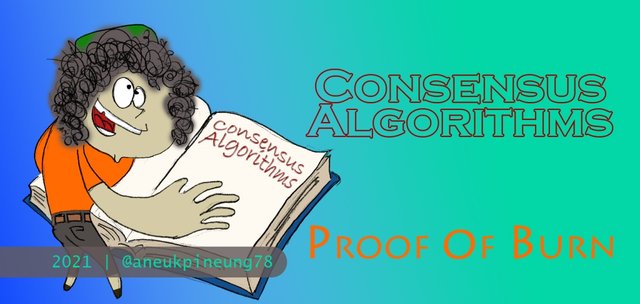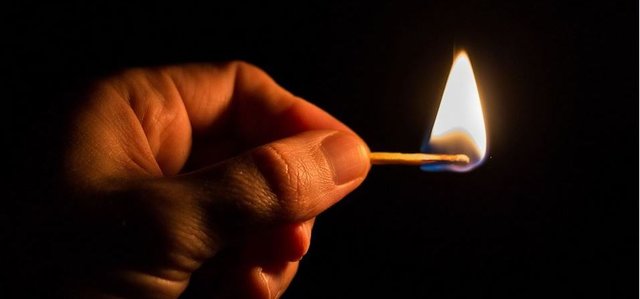Crypto Academy Week 13 - Homework Post for Professor @alphafx : Consensus Algorithms
This is my homework post for Steemit Crypto Academy Season 2 Week 5 for Professor @alphafx’s lesson Consensus Algorithms.

This week, Professor @alphafx wanted us to choose between any of this four types of Consensus Algorithms : Stellar Consensus Protocol, Proof of Capacity, Proof of Burn, and Proof of Elapsed Time, and write about it extensively. I choosed to write about Proof of Burn.
A blockchain network needs to ensure that all participating nodes come to an agreement about the true and valid state of the blockchain network. In general, consensus algorithms are some system of rules which are responsible to maintain the network security and for verifying and validating transactions. To obtain this, a blockchain network needs to run a consensus algorithm. There are several consensus algorithms used on the blockchain networks. One of them is Proof of Burn.
What is Proof of Burn?
There are several versions of Proof of Burn. But the concept idealized by Iain Stewart is probably the most popular within crypto world. And this writing is composed based on the idea by Iain Stewart.
Literally, Proof of Burn means the proof that someone has burned something. In blockchain, Proof of Burn means that a miner should be able to show proof that they burned some coins.
Burn some coins? Not burning them literally, burning coins on this term means that sending them to a verifiably unspendable address, so the coins will not be spendable anymore, because they have become inaccessible and useless. The verifiably unspendable address (also called “eater address” because this address “eats” coins sent there) is publicly verifiable but inaccessible, it has no private keys. It truly is unaccessible, even though it is verifiable. In another reality, this is similar to when publicly listed companies buy back their shares circulating among the general public, this will cause fewer shares to circulate outside the company and hence the ratio of net profit to be distributed will increase.
Why would miners burn their coins? By burning some coins and proof it, they will be granted the right to mine (write blocks and validating transaction) in proportion to the coins burnt. So, the more coins a user burns, the more mining power they will get and, by that, the higher their chances to be chosen as the next block validator.
What good does burning coins bring to blockchain? It is said that burning coins is able to suppress the inflation rate at the value of the coin in question. Antpool, a Bitcoin Cash (BCH) mining company, revealed that on April 20 they sent 12% of the coind they collected to an unreachable address, this lead to the slowing down of the inflation rate of Bitcoin Cash at that time.
Advantages of Proof of Burn
- Not like Proof of Work which consume many resources, the process of burning coins does not consume many resources (other than the burned coins).
- It also ensures that the network remains active and agile. And that is why Proof of Burn considered as “a more sustainable alternative to the Proof of Work consensus algorithm”.
- Coin burns, as Iain Stewart said, is the “virtual mining rigs”, so it has no need for mining hardwares.
- It reduces power consumption, so it is more sustainable
- Because of lower cost, it is very likely to encourage miners for long-term commitment.
- The mechanism of Proof of Burn is sustainable.
- Market scarcity or circulating supply might be reduced by coin burning.
Disadvantages of Proof of Burn
- So far, coin burning is likely not proven to work on larger scale.
- The verification of the miners’ works is not as fast as in the Proof of Work method. It tends to be delayed.
- There is opinion from some people that said that Proof of Burn is not ecological-friendly.
- The transparency of the burning process is still a problem since it is not easily verifiable by average users.
- Since it’s new, Proof of Burn method still needs further testings to confirm it’s security and efficiency.

Comparation to Proof or Work And Proof of Stake
Proof of Burn is considered as “a more sustainable alternative to the Proof of Work consensus algorithm”. This is the table of comparison of both Consensus Algorithms.
| Aspects | Proof of Burn | Proof of Work | Proof of Stakes |
|---|---|---|---|
| The Need For Mining Hardwares | No. | Yes, expensive. | Yes, expensive. |
| Capital Required | Cheapest on this list. | Most expensive on this list. | More expensive than PoB. |
| Operational Process | Miners provide proof that they have burned some coins, and by that they will be rewarded with the right to mine. The more coins burned, the more "power" they will be getting. | Miners provide the proof of their work in solving a complex cryptographic problem on blockchain. They compete each others. The first miner who come with a proof of work which then verified to be valid by the distributed network of nodes will then earn the right to permanently add the block into the blockchain, and they will also be rewarded with newly generated token. | The miners have to be able to proof the ownership of coins. The coins ownership is proven by a digital signature. The more coins staked by a forger, the higher the chances of being chosen as a block validator. |
| Energy Consumption | Lowest in this list. | Higher than PoB. | Higher than PoB. |
| Popular Project | Antpool (Bitcoin cash mining) | Bitcoin | BNB |
| Security & Efficiency | Lowest in this list. | Higher than PoB. | Higher than PoB. |
Conclusion
Proof of Burn has been mentioned as a strong alternative candidate to Proof of Work and Proof of Stake. In terms of ease of processing and the need for costs and resources, Proof of Burn can indeed be considered an attractive alternative to Proof of Work as well as Proof of Stake. However, Proof of Burn –in it’s early age like this- still needs improvements in several aspects including safety and efficiency. The time it takes to verify a miner's actions also needs to be shortened, in addition to transparency issues.
Thanks
Thanks Professor @alphafx for the lesson about Consensus Algorithms. Appreciate it.
Sources and Reading Suggestion
- https://academy.binance.com/en/articles/what-is-a-blockchain-consensus-algorithm
- https://www.geeksforgeeks.org/consensus-algorithms-in-blockchain/
- https://en.wikipedia.org/wiki/Consensus_(computer_science)
- https://whatis.techtarget.com/definition/consensus-algorithm
- https://coinmarketcap.com/alexandria/glossary/proof-of-burn-pob
- https://en.bitcoin.it/wiki/Proof_of_burn
- https://academy.binance.com/en/articles/proof-of-burn-explained
- https://www.investopedia.com/terms/p/proof-burn-cryptocurrency.asp
- https://bmmagazine.co.uk/business/how-you-describe-cryptocurrency-coin-burning/
- https://blog.iqoption.com/en/this-is-what-you-need-to-know-about-proof-of-burn/




Shared to Twitter : https://twitter.com/aneukpineung78a/status/1392059638657470467
Well done, although I would have liked to know projects that use this algorithm.
Thanks for participating
Thaks, Professor.